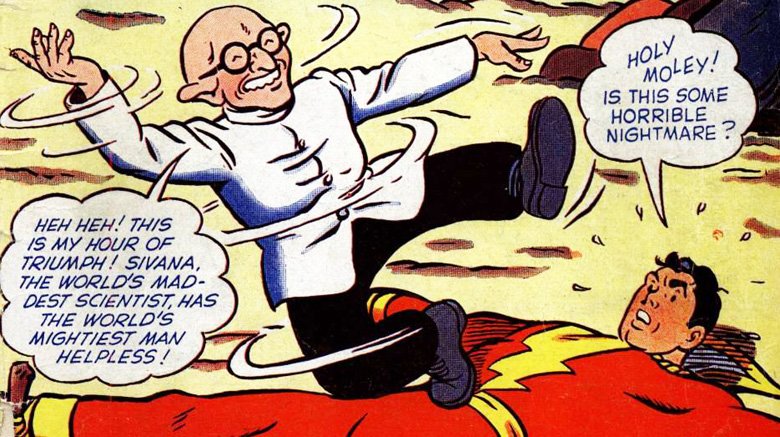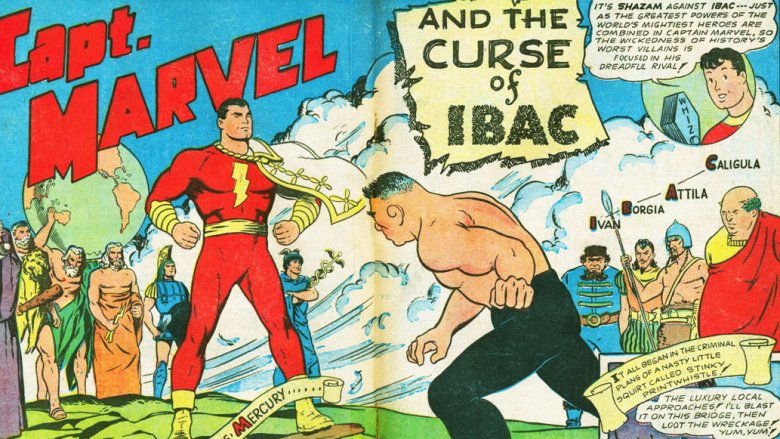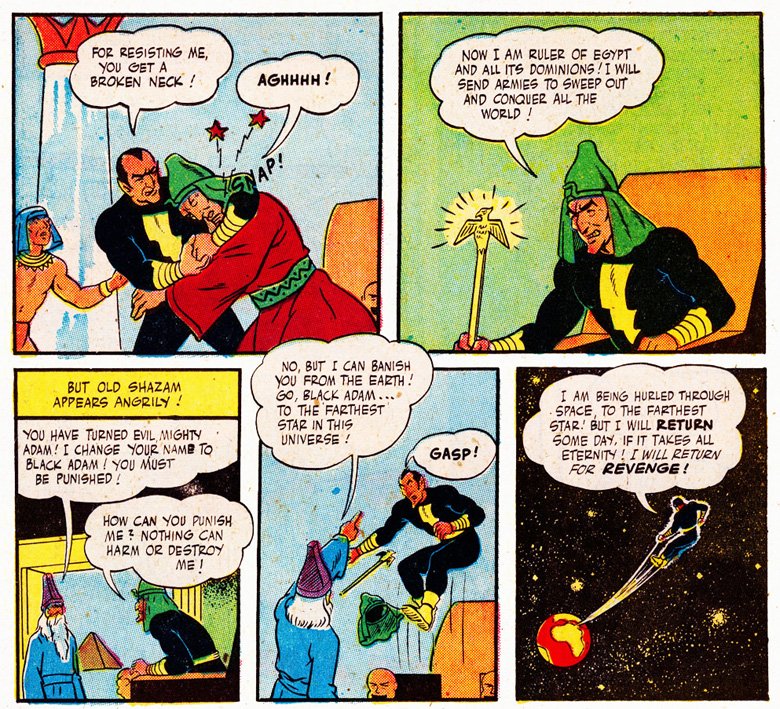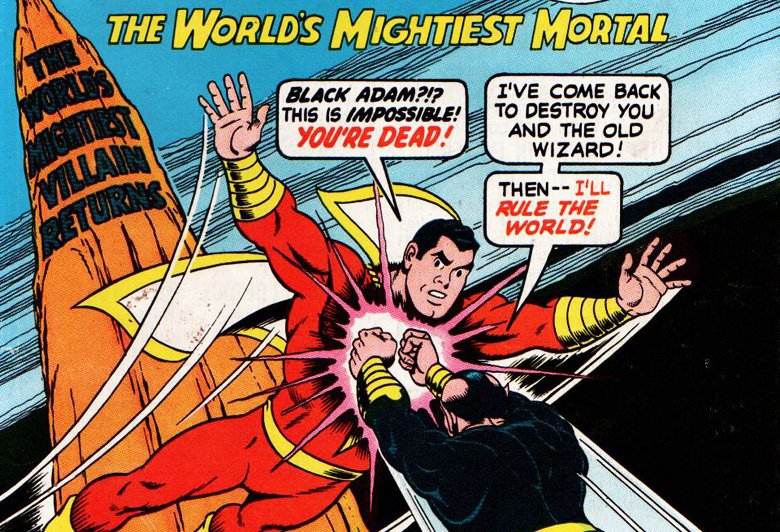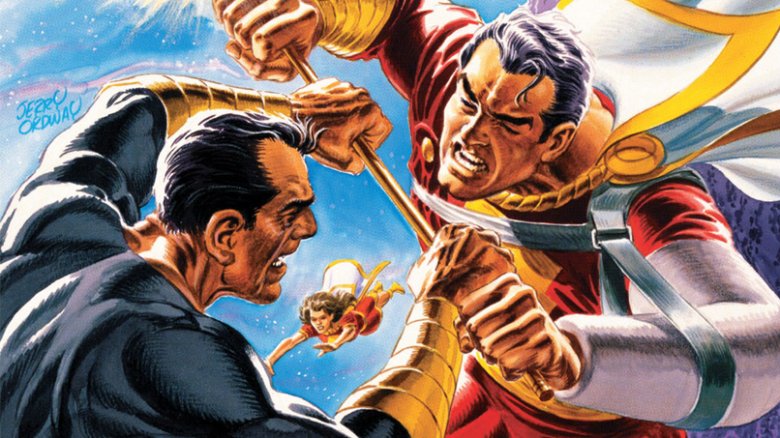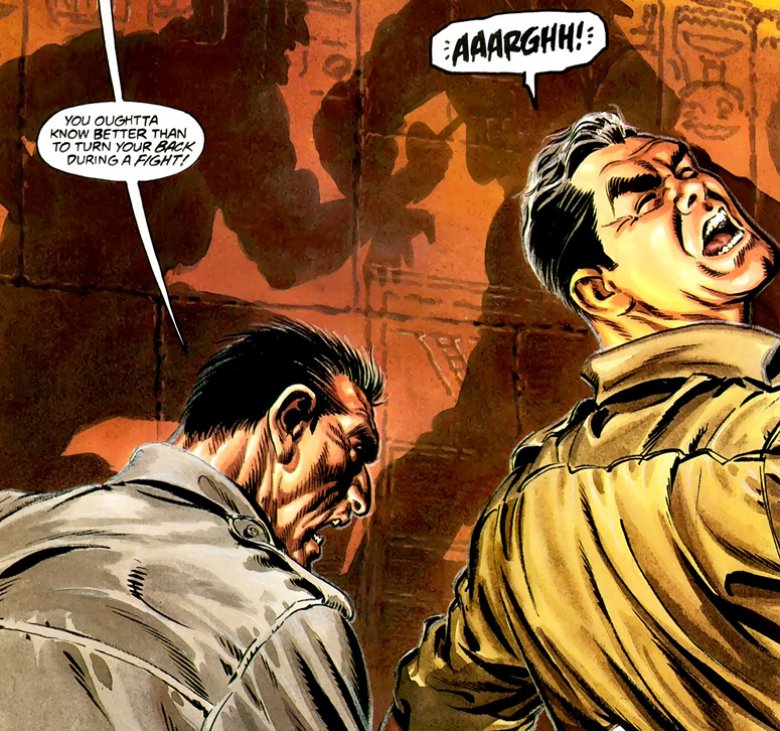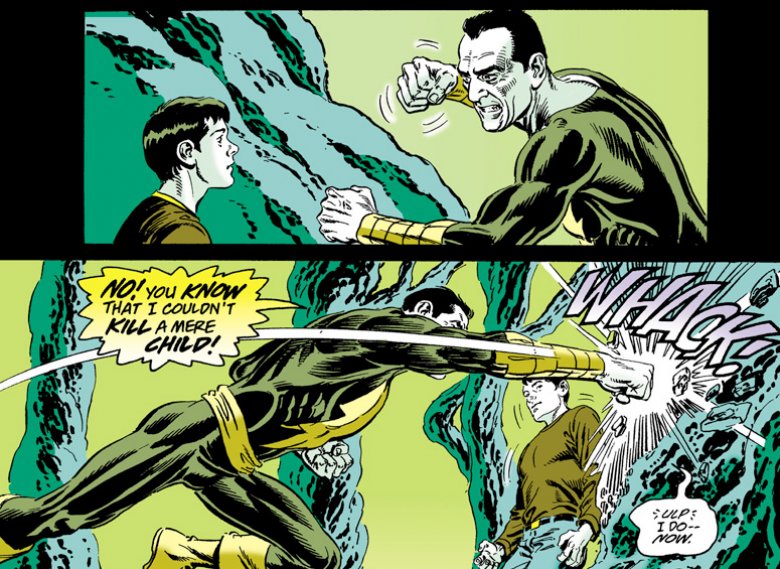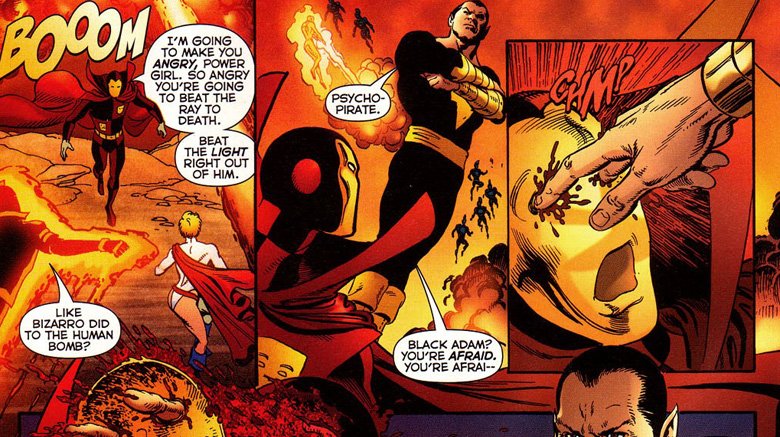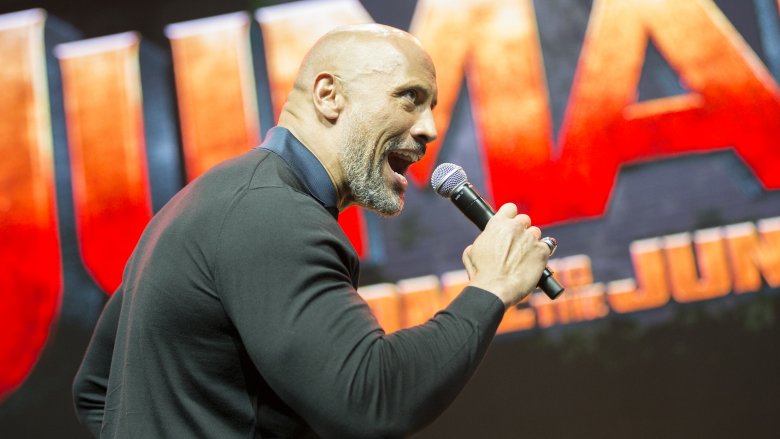Black Adam: The Untold Truth
Throughout the history of superheroes, no formula for creating a villain has been as reliable as simply giving a hero their evil opposite. Spider-Man has Venom, Superman has Bizarro, and Shazam — the World's Mightiest Mortal formerly known as Captain Marvel — has the deadliest of them all: Black Adam. Powered by the same mystical lightning that makes his red-and-gold-clad nemesis so formidable, Adam has all of Shazam's powers, only capped off with a ruthless willingness to destroy whatever gets in his way.
He's easily one of DC's most popular villains, and arguably Shazam's arch-nemesis... but that wasn't always the case. Black Adam's story is full of twists and turns, on as well as off the page, that cast him as hero, villain, and everything in between — including the 30 years when he wasn't even around at all. Say the word, and keep reading for the untold truth of Black Adam!
The Monster Society of Evil
While he's been riding high as Shazam's arch-nemesis for a good four decades now, Black Adam was actually a late and pretty minor addition to Captain Marvel's original rogues gallery. Instead, Billy Batson and his super-powered alter-ego had plenty of other threats to worry about — and the most prominent among them were about as far from the physical dominance of Black Adam as you could possibly get.
His first and most enduring enemy was Dr. Thaddeus Sivana, a bald super-scientist who dedicated his life to becoming the world's greatest criminal. If that sounds familiar, there's a good reason for that: once Fawcett Comics ceased publication in the '50s, its most prominent writer moved over to DC and spent the next few decades working on Superman. Over the next few decades, Otto Binder provided the Man of Steel with some of his most popular adventures. That said, Lex Luthor never conquered Venus, so score one for Dr. Sivana.
Captain Marvel's other most prominent villain? Mr. Mind, a tiny, telepathic worm from outer space. What he lacked in size, he made up for with deviousness and a dedication to evil, and was even the founder and leader of comics' first major supervillain team, whose evil designs ran through a full two-year story arc, a rarity for superhero comics at the time. It was called the Monster Society of Evil, and included virtually every foe that had fought Captain Marvel before, including a giant-sized robot called Mr. Atom, Captain Nazi, and assorted Crocodile-Men. Oh, and also Hitler, Mussolini, and the soldiers of every country that fought against the Allies in World War II. It's a pretty titanic roster of bad guys, but they wouldn't be complete without a sinister villain who tapped into the powers of a magic word to transform himself. It's just probably not the guy you're thinking of.
IBAC!
In 1942, Otto Binder and C.C. Beck introduced their first attempt attempt at giving Captain Marvel an evil opposite — the previous year's introduction of Captain Nazi notwithstanding. He might've had the codename, but his origin story was markedly different, combining Captain America and Doc Savage with an unhealthy dose of Hitler. Ibac, on the other hand, was the fun-house mirror version of Captain Marvel in virtually every way.
Like Billy Batson, Stinky Printwhistle — quite possibly the most unfortunate civilian name in the history of the superhero genre — was relatively weak in his normal form, and transformed with the aid of a magic word. Unlike Captain Marvel, however, he didn't involve mythological figures like Hercules or Zeus to draw upon their power. He pulled his rather nebulous abilities from some of history's most notorious figures, being empowered by Satan himself to invoke the terror of Ivan the Terrible, the cunning of Cesare Borgia, the fierceness of Atilla the Hun, and the cruelty of Caligula.
Upon saying "IBAC," Printwhistle would transform himself into a hulking, shirtless brute who, we can assume, was really into murdering his rivals in the Roman senate or bludgeoning his heir apparent to death with a scepter. Mostly, though, he fought Captain Marvel, who once punched him so hard that it knocked the historical figures right out of him. The idea was strong, though, and when it came time for them to launch another new comic featuring Fawcett's most popular character, Binder and Beck would revisit it in a pretty interesting way.
Black Adam appears
To say that Captain Marvel was popular in the '40s might be the biggest understatement in superhero history. He legendarily outsold Superman with the launch of his solo title, Captain Marvel Adventures, which ran biweekly alongside his other appearances in Whiz and Master Comics. And in 1945, Fawcett launched yet another title for Cap and his sidekicks, The Marvel Family, which would run for 89 issues.
For the launch of a new magazine, though, Binder and Beck knew they needed a pretty big story, and they made one. In "The Mighty Marvels Join Forces," they revealed that Billy Batson wasn't the first mortal that the wizard Shazam had chosen to wield his powers. The original was Teth-Adam, an Egyptian man who lived 5,000 years ago, and who was chosen for what the wizard saw as the purity of his soul. Unfortunately, as you've probably heard, power corrupts, and being the most powerful person on Earth quickly went to Adam's head.
After snapping a Pharaoh's neck — a bit of violence that's pretty shocking by Shazam standards, and would definitely inform later interpretations of the character — Adam was exiled by the wizard to "the farthest star," from which it coincidentally took him about 5,000 years to return. Unfortunately, those years caught up with him. When the Marvel Family tricked him into saying "Shazam," he turned back into Teth-Adam, and quickly aged so fast that he turned to dust before their eyes. And believe it or not, that's how he stayed for the next 30 years.
Back in Black
Sure, Black Adam died at the end of his first appearance, but this is a superhero comic. When has that ever stopped anyone from coming back? Heck, the Joker died at the end of his first appearance, too, and came back later in that same issue, so there's no reason Black Adam should be the one who stays gone for, say, 32 years. Even though Shazam comics weren't published between 1953 and 1975, you would've expected him to show up at some point in those eight years after his creation. And yet, in this case, dead was dead. For a while, at least.
After crumbling to dust in 1945, Black Adam wasn't seen again until DC started publishing Shazam in the '70s — with the title changed because Marvel Comics had, as you might expect, snapped up "Captain Marvel" in 1967 for their own cosmic hero. In Shazam #28, Dr. Sivana (with an assist from Otto Binder and legendary Superman artist Kurt Schaffenberger) employed a "Reincarnation Machine" to bring Adam back to life and set him loose to destroy Boston. In the fight that ensued, Captain Marvel managed to hit Black Adam so hard that he landed 200 years in the past.
Unfortunately for Adam, Cap battled his way back through the time stream, and Black Adam's second outing wound up going exactly the same way as his first one, right down to Uncle Dudley tricking him into saying "Shazam." The one big difference is that this time, he didn't crumble to dust, and stuck around long enough to cement himself as one of the Shazam family's greatest foes.
What's in a (magic) name?
If you're up on your comics trivia, you're probably aware that Shazam's magic word gave him the attributes of six mythological patrons: the wisdom of Solomon, the strength of Hercules, the courage of Achilles, the power of Zeus, the stamina of Atlas, and the speed of Mercury. Considering how similar they are, you might assume that Black Adam drew from the same sources for his own powers, but that turned out to not be the case.
One of the things that Binder and Schaffenberger added to Black Adam in his second appearance was the idea that he had his own set of deities from which to draw his powers. It's an idea they'd used before in a slightly more patronizing way, giving Billy's sister Mary Marvel a set of goddesses — Selena, Hippolyta, Ariadne, Zephyrus, Aurora, and Minerva gave her gifts like beauty and grace rather than stamina or courage. For Adam, though, they switched things over to Egyptian gods.
When Billy realized that being 5,000 years old put Black Adam squarely before the time of wise King Solomon, the wizard explained that he had the stamina of Shu, the strength of Hershef, the power of Amon, the wisdom of Zehuti, the speed of Anpu, and the courage of Menthu. If a few of those don't sound too familiar, well, there's a reason for that: in order to make it fit the acronym, Binder fudged it a little, using leser-known names for a few of the gods. Zehuti and Anpu, for instance, are definitely more well known as Thoth and Anubis. As for why he bothered to change Anubis, when it already fit, well, your guess is as good as ours.
Theo Adam and the Power of Shazam
In 1987, the Shazam Family was formally inducted into the DC Universe following Crisis on Infinite Earths, and that presented DC with a bit of a problem. Captain Marvel was, after all, cut from the same cloth as Superman — so much so, in fact, that DC sued Fawcett for copyright infringement in 1951, with the two companies settling out of court. That meant that he'd have to find a place in the universe that wasn't already occupied by his iconic Kryptonian counterpart, and while a few reboots tried to get there, it didn't really work until writer/artist Jerry Ordway relaunched The Power of Shazam in 1994 with a hardcover graphic novel followed by an ongoing series that ran for almost 50 issues.
One of Ordway's biggest changes in updating Captain Marvel for the '90s came from the way he reimagined Black Adam. He was the first creator to make Adam into the book's primary villain from the start — not just for Captain Marvel, but for Billy Batson, too.
Rather than just being an ancient Egyptian warrior, Ordway's take gave the villain a modern-day secret identity: Theo Adam, a greedy archaeologist who accompanied C.C. and Marilyn Batson on a dig, and murdered them in a fit of rage in order to get his hands on a priceless artifact. Even worse? That artifact was a representation of the wizard's power that allowed him to transform into Black Adam, becoming Captain Marvel's first and greatest arch-nemesis. Not only was he his evil opposite, he was also the guy who killed his parents, mixing a touch of Batman into Billy's origin.
Not guilty!
In 1999, Jerry Ordway added an interesting twist to Black Adam. Not only did Adam start saving lives instead of just trying to murder Billy Batson and finish the job his alter ego started in Egypt, he also turned himself in to the Justice League, claiming he could prove he was innocent of Theo Adam's crimes. It worked, too — after he claimed that Theo Adam and Teth-Adam were actually two different people who happened to share a body due to the wizard's magic, and that every evil act had been done under Theo's influence before Teth-Adam had been able to regain control. The crucial piece of evidence in court, though, was far less mystical: it turned out Black Adam's fingerprints didn't match Theo's.
Needless to say, Billy Batson suspected that this was all an elaborate ruse to take advantage of the fact that the magic gave Theo a different body. That might seem uncharitable, but it turns out that "he stabbed my parents and left them to die in an ancient tomb and then tried to murder me, my sister, and my best friend several times" is the sort of problem that the old "it wasn't me" defense doesn't exactly cover. As a result, the two wound up fighting at the behest of the wizard to determine who would be his champion on Earth, and who would be condemned to an eternity in the underworld. In that fight, Adam proved that he would not kill Billy and was willing to sacrifice himself, showing that maybe the wizard had been right all those years ago when he thought he had a pure soul.
With that, Adam was reformed... more or less. While he still occasionally found himself operating as a supervillain due to the lingering influence of Theo Adam's personality trapped within him, Adam was heroic enough that he even joined the Justice Society of America. He never did get away from his tendency towards violence, though.
The ultra-violent king of Khandaq
Remember how Black Adam's very first appearance in 1945 started off with him snapping a dude's neck and taking over his country? Despite his seeming reformation, that tendency towards shocking on-panel murder was something that remained a part of Adam's character all the way through the modern age — and unsurprisingly, was ramped up to the extreme along the way.
As part of a retcon, it was revealed that Adam's origin took place in the fictional country of Khandaq, and in 2005, he returned to finish the job he'd started 5,000 years before. After a violent takeover, he declared himself to be the country's "Guardian," but his tendency towards diplomacy went about as well as... well, about as well as you'd expect diplomacy to go when it involves a supervillain best known for trying (and failing) to murder a child. He even sparked a massive global conflict that was dubbed "World War III" (one of several comics events to be so named), and resulted in a huge number of on-panel deaths.
For Adam, this was a period marked by ridiculously extreme acts of violence. The most famous is undoubtedly the panel where he shoved the Psycho Pirate's eyes through the back of his head, but he also killed Terra from the Teen Titans by punching his hand through her torso, and at one point, after being stripped of his powers, even resorted to cannibalism. The idea, it seems, was to make him as dark as Shazam was bright, but it's easy to argue that creators of that era went too far. When Black Adam was rebooted once again in 2011, that level of blood and gore was apparently left behind.
Black Adam on the screen
After his rise to prominence as one of DC's greatest villains in the '80s and '90s and the continued fascination with his character, it's no surprise that Adam has managed to appear in multiple projects outside of comics.
As you'd expect, he was a villain in the short-lived 1981 Kids Super Power Hour With Shazam. In a story based on his first appearance in comics, Teth-Adam showed up in a flashback to ancient Egypt in an episode of Justice League Unlimited, and he had a minor appearance in Young Justice. More prominently, though, he and Dr. Sivana were the villains of an episode of Batman: The Brave and the Bold, where he was voiced by the incredibly prolific John DiMaggio, who also provided the voice of that show's take on Aquaman, as well as Futurama's Bender and Adventure Time's Jake the Dog.
Most recently, Adam appeared as a villain on a Shazam-centric episode of Justice League Action, with a pretty amazing choice for a voice actor. This time around, he was played by Gary Cole, an accomplished actor who's been in everything from Talladega Nights to Bob's Burgers to the Brady Bunch movies. You may know him best, however, as Bill Lumbergh, the painfully laconic manager from Office Space. Just imagine Black Adam asking where those TPS reports and if you can come in on Saturday, and you'll know how sinister that villain can be.
If you smell what Black Adam's cookin'
The biggest piece of Black Adam news to come along... well, ever has undoubtedly been the casting of Dwayne "The Rock" Johnson as the character in DC's shared cinematic universe. After years of being attached to a Shazam film, it was revealed that Johnson wouldn't be playing Shazam, but would rather be taking on the role of Teth-Adam. The weird part, though, is that he apparently won't be showing up in the 2019 Shazam! film, which has Dr. Sivana slated as its villain. Instead, he may make his first appearance in the sequel to Suicide Squad.
As exciting as that is, it's also pretty surprising when you consider that Shazam is based on the childhood power fantasy of a kid who can transform into the coolest adult he can imagine. With that in mind, Johnson seems like a natural fit for the hero — what kid wouldn't want to say a magic word and turn into the Rock?
Johnson will undoubtedly turn in a solid performance as Black Adam, but honestly, the only way that casting works better than having him as the hero is if they had cast John Cena, the only jacked muscleman that kids today like even more than Johnson, to play Shazam. Then again, maybe the producers saw WrestleMania 29 and decided that a fight between those two probably wouldn't be as entertaining as we all hoped it would be.
